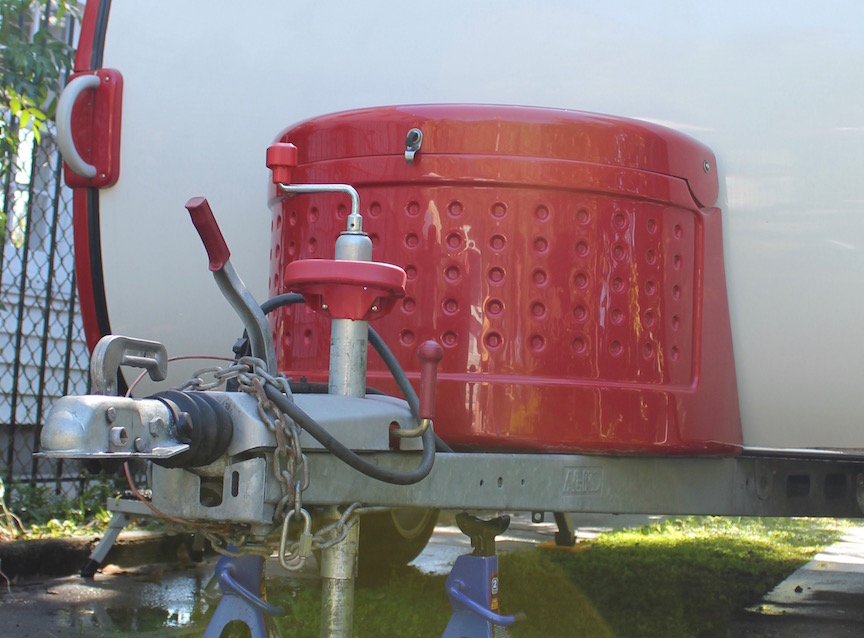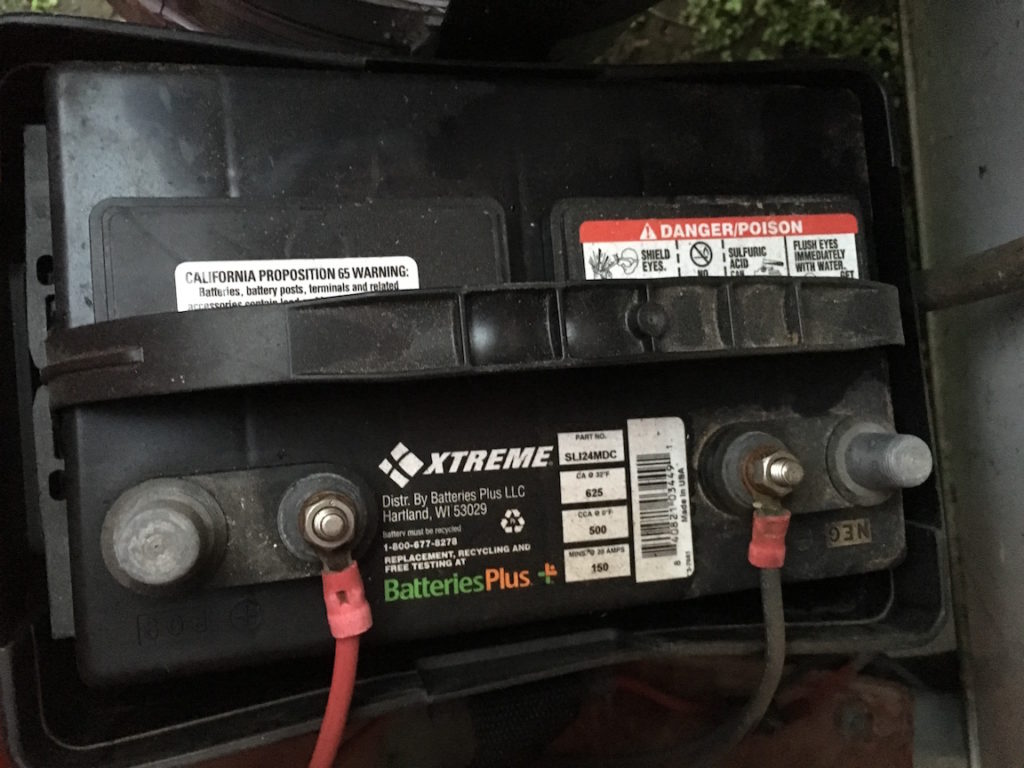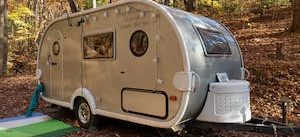
When I bought my 2007 T@B trailer in late 2016, I had no idea about the age or condition of the deep-cell battery that is housed in the “bucket” at the front of the rig. Just opening the top of the bucket and looking inside was a major drama. Click here to see what I mean.
At the time, I just couldn’t emotionally handle figuring out the battery: its age, condition, even its purpose. It was there. The trailer functioned. Let’s just leave it at that, I thought.
But a year into my travels, I guess the powers that be decided I was ready to face down the battery issue. And I know that because the battery stopped working. That was the clue I needed.

I did have a “warning problem” a few months ago when a few of the items in my trailer that can run on battery power alone started flickering and failing. Those included the 3 wall sconces inside the trailer, the porch light, the ceiling fan, and the refrigerator.
I started researching online what the problem could be. Was it a blown fuse? A tripped breaker? A massive electrical disaster? Eventually I realized it could be the battery. I opened the top of the bucket, unstrapped the battery case, lifted off the plastic case lid, and used a flathead screwdriver to pop the 2 caps off the battery cells. The water in there was way low. I am guilty of battery abuse.
I went to the store and bought a jug of distilled water as instructed by the online geniuses. The minerals in drinking water would harm the plates in the battery. I filled the battery up and it began functioning. I promptly put the issue to bed, filled up the dog bowl with the rest of the distilled water, and blindly carried on.
The battery issue came back to bite me a few days ago. I was sitting in meditation, probably dosing off a bit, when I realized that the converter under the bench seat, which I rarely hear and which apparently charges the battery when I’m plugged into what’s called “shore power,” was running incessantly. Something was clearly wrong. I started calculating how much money is in my emergency fund and how far that would go in getting a remote RV technician out there to diagnose and fix my electrical problems.
In the meantime, I went outside to the tub, popped open the battery caps, and saw that the water in there was bubbling and boiling. Uh oh. Was it about to explode?

I immediately jumped onto my T@B Facebook forum and started asking what the problem could possibly be. I got responses within a few minutes. It might be that I killed the battery by letting it run out of water and the converter was trying and trying to charge it. It might be that the converter was bad and overcharging the battery. It all sounded bad. Really bad. At some suggestions, I added water to the battery and waited to see if the problem resolved. It did not.
With some back and forth dialogue with the helpful members of this online group, I decided on the following course of action: 1) Take out the old battery, 2) Go buy a new battery, 3) Install the new battery, 4) Check the charge on the battery terminals with a multimeter to see if it’s charging at 13.6 volts, and not 12 or lower and not 14 or higher. (All of No. 4 is totally gibberish to me. But I’m following directions.)
Happily for me, my friend Cheri offered to come over and help me with the battery. What a great friend. She just instinctively knew how beneficial it would be to have a pal as I executed this advanced technical task. She took out her cell phone and took a picture of the battery so we would recall how to hook the new one back up.
For safety, I unplugged the whole trailer from shore power. I got out my large tool kit and discovered through trial and error that the nuts holding the terminals to the posts were 1/2 inch. I used a socket and socket wrench to loosen each nut. I’m feeling quite macho at this point. Cheri had consulted with her brother about this prior to coming over, and he had warned about touching the negative and positive posts with something like a metal wrench and thus creating an electrical current, a spark, and possibly an explosion. I think.
I got the battery loosened from the wires and hoisted it out of the battery case. It was heavy! I placed it into the black bag I had ready, put it in the back of the car, and we took off. But where to go? We thought Costco had the best prices. I pulled up at the tire section and walked into the little office. A long line of disgruntled-looking people stood waiting at the register. I butted in and asked the clerk if they sold RV batteries. She said: “Marine batteries?” I shrugged. She tilted her head and said there were some over there. I looked over there and realized: I need real help. I need guidance. Costco is not right for me.
I got back in the car and searched with the GPS for Batteries Plus. That’s when we saw the AutoZone. We brought the battery to the counter and a very talkative young man got out a meter and started to test it. He asked how our day was going. He asked how our Fourth of July went. I’m thinking: “Shut up! I need a battery!” I believe that talkative young man would do better in some other retail establishment. Anyone who comes to AutoZone probably has some car problems and is not in the mood to chat about picnic food.
Unable to get a reading on his meter, he finally took the battery to the shift manager, and she tested it and declared it dead. She pointed to a marine battery that she recommended. I was leery. Will this hurt my trailer? She said she lived in an RV for 5 years, though it sounded like those were not her finest years, and so she knew about deep-cell batteries. That was good enough for me. I bought it, along with a $20 multimeter, and a $1.95 package of gel to put on the terminals to keep them from corroding. Cheri bought a few items for her own upcoming road trips.
Back at The Tiny, we lifted the new battery into the bucket, and I began to hook up the terminals. I did the red wire first, the positive, and then started on the black wire, the negative. At that point, we started to see sparks. Cheri called her brother and he said small sparks were OK. He also said to use all the gel in the packet as you can never have too much. He joked that we women were learning so much that soon men will be unnecessary.
Once the new battery was installed, I plugged the trailer back into the house power, and OMG! The lights and the CoolCat AC and all of the trailer electrical things started working! And the converter was not running or humming.
At that point, I was supposed to check the battery to see if it was being charged properly by the converter. But I was exhausted. Cheri wanted to stick around and see if the converter was OK, but she had to get to work. I told her I needed a nap before figuring out how to use the multimeter. After I rested, I watched some YouTube videos and then took the thing out of the package, put the two probes on the two terminals, and I’ll be damned if that thing didn’t read 13.45 volts, indicating the converter under the bench seat was operating perfectly. I was so happy I could cry!
You only get to replace a trailer battery the first time once in your whole life. You only get to purchase your first multimeter once in your whole life. You only get to test a battery with the multimeter for the first time once in your whole life. Like Thelma said in “Thelma and Louise,” “Something’s crossed over in me. I can’t go back.” And as Louise said: “I know. I know what you mean.” Thank you all for witnessing the story of my crossing over. Life will never be the same.
